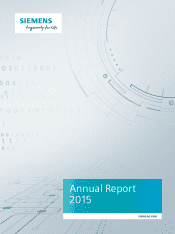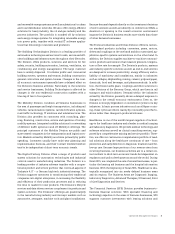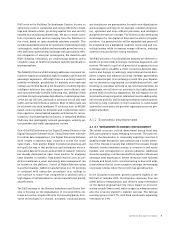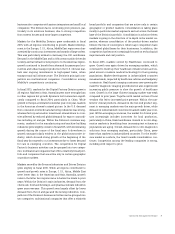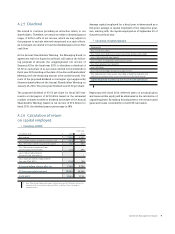Siemens 2015 Annual Report Download - page 7
Download and view the complete annual report
Please find page 7 of the 2015 Siemens annual report below. You can navigate through the pages in the report by either clicking on the pages listed below, or by using the keyword search tool below to find specific information within the annual report.Combined Management Report
R & D work at the Building Technologies Division focuses on
optimizing comfort, operational and energy efficiency in build-
ings and infrastructures, protecting against fire and security
hazards, and minimizing related risks. We aim to create a port-
folio of products and services ranging from the field level to
the cloud, based on open standards wherever possible. This
includes data-based services for new ways of optimizing energy
consumption, easily scalable and reasonably priced services, a
new and harmonized system landscape with particularly effec-
tive integration of electrical consumption, fire detection and
HVAC (heating, ventilation, air conditioning) systems, and a
complete range of field-level products tailored specifically to
growing markets.
The Mobility Division’s R & D strategy addresses customers’ de-
mand for maximum availability, high throughput and enhanced
passenger experience. Although there is a growing need for
mobility worldwide, possibilities for building new roads and
railways are limited. Meeting the demand for mobility requires
intelligent solutions that make transport more efficient, safe
and environmentally friendly. Reflecting this, Mobility’s R & D
activities strongly emphasize digitalization in developing state-
of-the art rail vehicles, automation solutions for rail and road
traffic, and rail electrification systems. Most of these goals can
be achieved only with intelligent IT solutions such as WLAN-
based control systems for driverless and conductorless metro
train operation, decentralized wayside architecture for rail au-
tomation, cloud-based product solutions, or Integrated Mobility
Platforms that intelligently network passengers, mobility ser-
vice providers and traffic management centers.
One of the R & D priorities at the Digital Factory Division is the
Digital Enterprise Software Suite. Using Teamcenter software
for central data management, the Digital Enterprise Software
Suite creates a seamless data connection across the entire
value chain – from product design to production planning and
set-up all the way to real production and subsequent service.
Innovative data services are another field of research: Siemens
has already developed an open cloud solution for analyzing
large datasets in industry. Data-based services such as pre-
dictive maintenance, asset and energy data management can
be hosted on this platform. Control of Hybrid Manufacturing
is another example. Additive manufacturing (e. g. D printing)
is combined with subtractive procedures (e. g. milling) in
one machine to ensure that components or products with a
high degree of individualization can be manufactured quickly
and efficiently.
The R & D strategy of the Process Industries and Drives Divi-
sion is focusing on the digitalization of crucial portfolio ele-
ments across the complete lifecycle of processing plants. Inno-
vative technologies for sensors, actuators, communications
and simulations are prerequisites for end-to-end digitalization
and automation and require, for example, consistent engineer-
ing, optimized and more efficient processes, and intelligent
and predictive service concepts. The Division is also developing
technologies for the digital oil field and the electric propeller
pod drive. Our gears portfolio will be expanded and gears will
be integrated into a digitalized condition monitoring and con-
trolling system while increasing energy efficiency, reducing
material costs and further cutting emissions.
The R & D activities of our Healthcare business are directed to-
wards our growth fields in therapy, molecular diagnostics, and
services. We want to tap the full potential of imaging solutions
in therapy and to establish a closer connection between diag-
nostics and therapy in cardiology, interventional clinical disci-
plines, surgery, and radiation oncology. Strategic partnerships
are an essential part of our strategy to reach this goal. Expand-
ing our innovation map beyond our established portfolio, and
investing in new ideas will help us tap new business fields. As
an example, we will drive our activities in the highly dynamic
growth field of molecular diagnostics. We will expand our ser-
vices business beyond product-related services by adding a dig-
ital services portfolio and increasing enterprise transformation
services to help customers in their transition to value-based
care within more and more provider organizations across geo-
graphical borders.
A.1.2 Economic environment
A.1.2.1 WORLDWIDE ECONOMIC ENVIRONMENT
The global economic outlook deteriorated during fiscal year
, particularly for many emerging economies. The main rea-
son for the deceleration in commodity exporting countries is
globally weaker demand for raw materials and a further soften-
ing of the Chinese economy that suffered from weaker foreign
demand, slower investment activity, a correction in real estate
markets, and overcapacities in several industries. Additional
stress for emerging countries resulted from capital outflows and
exchange rates depreciation. Severe recessions have followed
in Russia and Brazil, both countries having to deal with addi-
tional adverse shocks. A rare exception amongst the emerging
economies is India, where the recovery has gained traction.
In the European economies, growth improved slightly in the
first half of calendar . Uncertainties stemming from the
Greek bailout renegotiations and Greece’s snap referendum
on the bailout proposal had only minor impact on economic
activity outside Greece itself, which is again in a deep recession
after the economy started to stabilize last year. The German
economy grew a solid . %, with fixed investments expanding
even faster at . %.

